A knock-in mutation at cysteine 144 of TRIM72 is cardioprotective and reduces myocardial TRIM72 release
- PMID: 31536744
- PMCID: PMC7000244
- DOI: 10.1016/j.yjmcc.2019.09.008
A knock-in mutation at cysteine 144 of TRIM72 is cardioprotective and reduces myocardial TRIM72 release
Abstract
TRIM72 is a membrane repair protein that protects against ischemia reperfusion (I/R) injury. We previously identified Cys144 (C144) on TRIM72 as a site of S-nitrosylation. To study the importance of C144, we generated a knock-in mouse with C144 mutated to a serine (TRIM72 C144S). We subjected ex vivo perfused mouse hearts to 20 min of ischemia followed by 90 min of reperfusion and observed less injury in TRIM72 C144S compared to WT hearts. Infarct size was smaller (54 vs 27% infarct size) and cardiac functional recovery (37 vs 62% RPP) was higher for the TRIM72 C144S mouse hearts. We also demonstrated that TRIM72 C144S hearts were protected against I/R injury using an in vivo LAD occlusion model. As TRIM72 has been reported to be released from muscle we tested whether C144 is involved in TRIM72 release. After I/R there was significantly less TRIM72 in the perfusate normalized to total released protein from the TRIM72 C144S compared to WT hearts, suggesting that C144 of TRIM72 regulates myocardial TRIM72 release during I/R injury. In addition to TRIM72's protective role in I/R injury, TRIM72 has also been implicated in cardiac hypertrophy and insulin resistance, and secreted TRIM72 has recently been shown to impair insulin sensitivity. However, insulin sensitivity (measured by glucose and insulin tolerance) of TRIM72 C144S mice was not impaired. Further, whole body metabolism, as measured using metabolic cages, was not different in WT vs TRIM72 C144S mice and we did not observe enhanced cardiac hypertrophy in the TRIM72 C144S mice. In agreement, protein levels of the TRIM72 ubiquitination targets insulin receptor β, IRS1, and focal adhesion kinase were similar between WT and TRIM72 C144S hearts. Overall, these data indicate that mutation of TRIM72 C144 is protective during I/R and reduces myocardial TRIM72 release without impairing insulin sensitivity or enhancing the development of hypertrophy.
Copyright © 2019 Elsevier Ltd. All rights reserved.
Figures
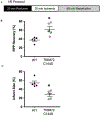
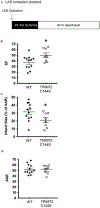
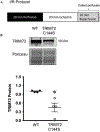
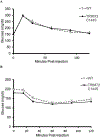

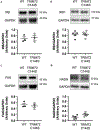
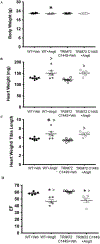
Similar articles
-
S-nitrosylation of TRIM72 at cysteine 144 is critical for protection against oxidation-induced protein degradation and cell death.J Mol Cell Cardiol. 2014 Apr;69:67-74. doi: 10.1016/j.yjmcc.2014.01.010. Epub 2014 Jan 30. J Mol Cell Cardiol. 2014. PMID: 24487118 Free PMC article.
-
Protease-activated receptor 2-mediated protection of myocardial ischemia-reperfusion injury: role of transient receptor potential vanilloid receptors.Am J Physiol Regul Integr Comp Physiol. 2009 Dec;297(6):R1681-90. doi: 10.1152/ajpregu.90746.2008. Epub 2009 Oct 7. Am J Physiol Regul Integr Comp Physiol. 2009. PMID: 19812353 Free PMC article.
-
Overexpression of the muscle-specific protein, melusin, protects from cardiac ischemia/reperfusion injury.Basic Res Cardiol. 2014 Jul;109(4):418. doi: 10.1007/s00395-014-0418-9. Epub 2014 May 25. Basic Res Cardiol. 2014. PMID: 24859929
-
Endothelial insulin resistance protects the heart against prolonged ischemia-reperfusion injury but does not prevent insulin transport across the endothelium in a mouse Langendorff model.J Cardiovasc Pharmacol Ther. 2014 Nov;19(6):586-91. doi: 10.1177/1074248414525506. Epub 2014 Mar 19. J Cardiovasc Pharmacol Ther. 2014. PMID: 24651518
-
Adenosine A2A receptor activation reduces infarct size in the isolated, perfused mouse heart by inhibiting resident cardiac mast cell degranulation.Am J Physiol Heart Circ Physiol. 2008 Nov;295(5):H1825-33. doi: 10.1152/ajpheart.495.2008. Epub 2008 Aug 29. Am J Physiol Heart Circ Physiol. 2008. PMID: 18757481 Free PMC article.
Cited by
-
S-Nitrosylation in Cardiovascular Disorders: The State of the Art.Biomolecules. 2025 Jul 24;15(8):1073. doi: 10.3390/biom15081073. Biomolecules. 2025. PMID: 40867518 Free PMC article. Review.
-
Nitrosative Stress and Human Disease: Therapeutic Potential of Denitrosylation.Int J Mol Sci. 2021 Sep 10;22(18):9794. doi: 10.3390/ijms22189794. Int J Mol Sci. 2021. PMID: 34575960 Free PMC article. Review.
-
MG53, A Tissue Repair Protein with Broad Applications in Regenerative Medicine.Cells. 2021 Jan 11;10(1):122. doi: 10.3390/cells10010122. Cells. 2021. PMID: 33440658 Free PMC article. Review.
-
Blocking MG53S255 Phosphorylation Protects Diabetic Heart From Ischemic Injury.Circ Res. 2022 Dec 2;131(12):962-976. doi: 10.1161/CIRCRESAHA.122.321055. Epub 2022 Nov 7. Circ Res. 2022. PMID: 36337049 Free PMC article.
References
-
- Kohr MJ, Evangelista AM, Ferlito M, Steenbergen C & Murphy E S-nitrosylation of TRIM72 at cysteine 144 is critical for protection against oxidation-induced protein degradation and cell death. Journal of molecular and cellular cardiology 69, 67–74, doi:10.1016/j.yjmcc.2014.01.010 (2014). - DOI - PMC - PubMed
Publication types
MeSH terms
Substances
Grants and funding
LinkOut - more resources
Full Text Sources
Molecular Biology Databases
Research Materials

